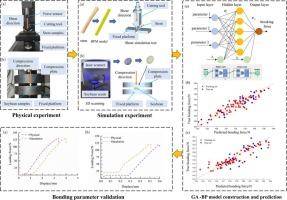A study on the calibration method of bonding parameters for soybean threshing materials based on GA-BP model and whale optimization algorithm
IF 4.6
2区 工程技术
Q2 ENGINEERING, CHEMICAL
引用次数: 0
Abstract
The simulation of grain and stem breakage mechanisms during the soybean threshing process can effectively reveal the interaction mechanisms between threshing materials and operating components; however, its accuracy is highly dependent on the precision of the bonding parameters. To address the lack of accurate bonding parameters for soybean threshing materials, this study proposes a calibration method that integrates a GA-BP neural network with the whale optimization algorithm. First, shear tests of stems and compression tests of grains were conducted to obtain the ultimate load, which served as the reference index for parameter calibration. Subsequently, a predictive model for soybean threshing materials was constructed, and parameter optimization was achieved in combination with the whale optimization algorithm. Finally, the effectiveness of the calibrated parameters was verified by comparing simulation results with experimental data. The results demonstrated that the relative errors between the simulated and measured failure loads of stems and grains under the calibrated parameters were 0.38 % and 1.41 %, respectively, confirming the accuracy and reliability of the proposed method. This study not only provides precise bonding parameters for soybean threshing materials but also offers important references for discrete element method-based threshing mechanism studies and parameter calibration of other materials.
Science4Impact statement
This study addresses the lack of accurate bonding parameters for soybean threshing materials by proposing a calibration method that integrates a genetic algorithm-optimized BP neural network with the Whale Optimization Algorithm for bonding parameter optimization. Compared with RF, SVR, and RBF models, the BP neural network demonstrated superior prediction accuracy and generalization ability. Additionally, the Whale Optimization Algorithm outperformed the genetic algorithm in terms of convergence speed and optimization efficiency. Validation tests of the optimal bonding parameters showed that the mechanical response of the calibrated soybean threshing materials exhibited minimal error compared to the actual load, indicating high accuracy and reliability.

基于GA-BP模型和鲸鱼优化算法的大豆脱粒物料粘接参数标定方法研究
通过对大豆脱粒过程中籽粒和茎断机制的模拟,可以有效地揭示脱粒物料与操作部件之间的相互作用机制;然而,其精度高度依赖于键合参数的精度。针对大豆脱粒材料缺乏准确的粘接参数的问题,本研究提出了一种将GA-BP神经网络与鲸鱼优化算法相结合的校准方法。首先进行茎杆剪切试验和籽粒压缩试验,获得极限荷载,作为参数标定的参考指标;随后,构建了大豆脱粒物料预测模型,并结合whale优化算法实现了参数优化。最后,通过仿真结果与实验数据的对比,验证了标定参数的有效性。结果表明,在标定参数下,茎杆和籽粒破坏载荷的模拟值与实测值的相对误差分别为0.38%和1.41%,验证了所提出方法的准确性和可靠性。该研究不仅为大豆脱粒材料提供了精确的粘接参数,也为基于离散元法的脱粒机理研究和其他材料的参数标定提供了重要参考。本研究提出了一种结合遗传算法优化的BP神经网络和Whale优化算法进行粘接参数优化的校准方法,解决了大豆脱粒材料粘接参数缺乏准确的问题。与RF、SVR和RBF模型相比,BP神经网络具有更好的预测精度和泛化能力。此外,Whale优化算法在收敛速度和优化效率方面都优于遗传算法。验证试验表明,标定后的大豆脱粒材料力学响应与实际载荷误差最小,具有较高的准确性和可靠性。
本文章由计算机程序翻译,如有差异,请以英文原文为准。
求助全文
约1分钟内获得全文
求助全文
来源期刊

Powder Technology
工程技术-工程:化工
CiteScore
9.90
自引率
15.40%
发文量
1047
审稿时长
46 days
期刊介绍:
Powder Technology is an International Journal on the Science and Technology of Wet and Dry Particulate Systems. Powder Technology publishes papers on all aspects of the formation of particles and their characterisation and on the study of systems containing particulate solids. No limitation is imposed on the size of the particles, which may range from nanometre scale, as in pigments or aerosols, to that of mined or quarried materials. The following list of topics is not intended to be comprehensive, but rather to indicate typical subjects which fall within the scope of the journal's interests:
Formation and synthesis of particles by precipitation and other methods.
Modification of particles by agglomeration, coating, comminution and attrition.
Characterisation of the size, shape, surface area, pore structure and strength of particles and agglomerates (including the origins and effects of inter particle forces).
Packing, failure, flow and permeability of assemblies of particles.
Particle-particle interactions and suspension rheology.
Handling and processing operations such as slurry flow, fluidization, pneumatic conveying.
Interactions between particles and their environment, including delivery of particulate products to the body.
Applications of particle technology in production of pharmaceuticals, chemicals, foods, pigments, structural, and functional materials and in environmental and energy related matters.
For materials-oriented contributions we are looking for articles revealing the effect of particle/powder characteristics (size, morphology and composition, in that order) on material performance or functionality and, ideally, comparison to any industrial standard.
 求助内容:
求助内容: 应助结果提醒方式:
应助结果提醒方式:


